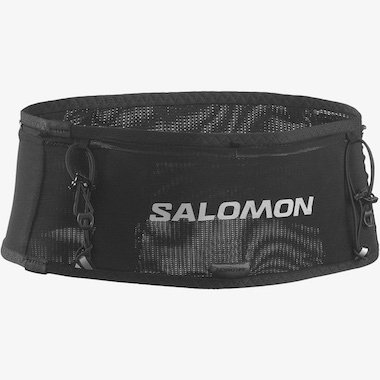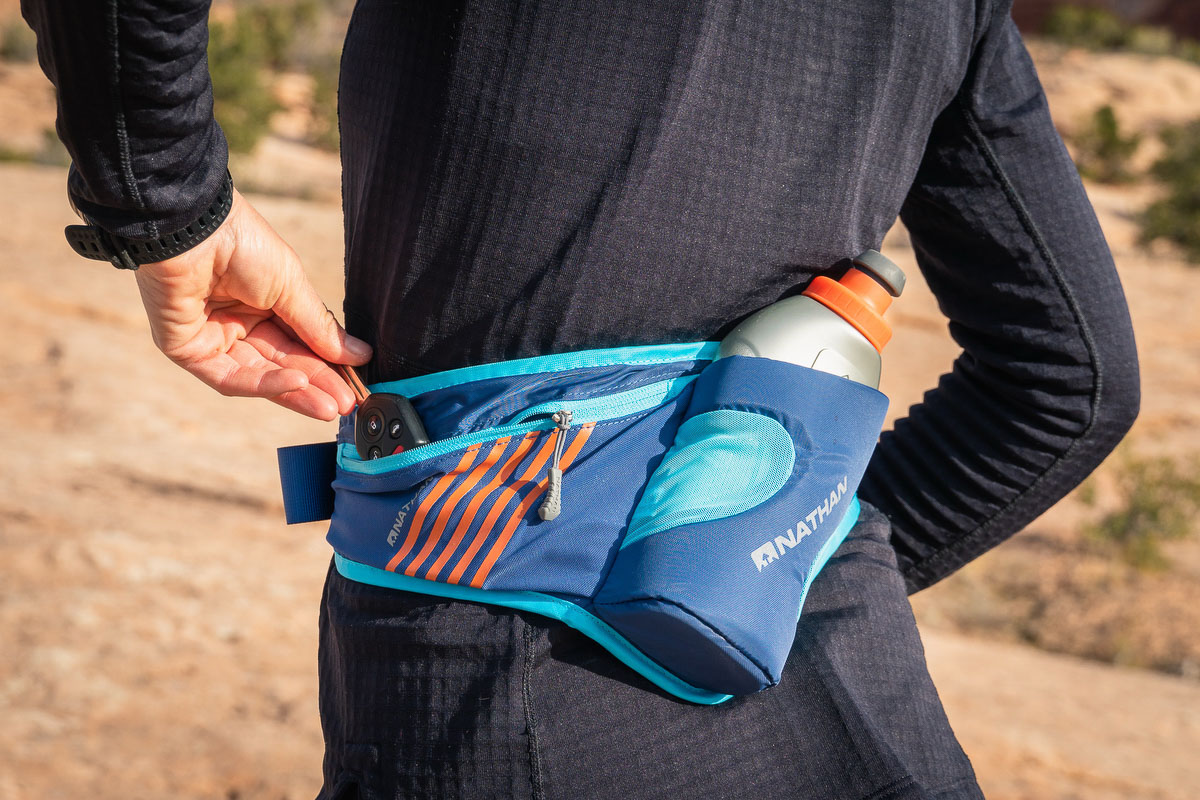
The Nathan 5k Race Belt is perfect for races and short jaunts where you don’t need water and need only to carry small items like a phone and key. Photo: iRunFar/Eszter Horanyi
Running belts and waistpacks offer a way to carry supplies and gear, such as water, snacks, an extra clothing layer, your phone, keys, cards, money, and sometimes even hiking poles, in a hyper-compact spot around your waist. The best running belt will fit comfortable, stay still when you run, and have easily accessible pockets for the items you need.
Ranging from minimalist mini-belts just big enough for a smartphone to ultramarathon-worthy running hydration waistpacks that can fully substitute for a vest, the running belt and waistpack market is so large and diverse that it can be hard to decide what you might need. iRunFar searched far and wide and logged loads of miles in a few dozen products to bring you the best running belts and waistpacks available today. Our choices fit into three general categories: tube-style belts, mini-belts, and larger waistpacks built for carrying hydration.
You can learn a bit more about how to choose the best running belt for you by jumping down to our how-to-choose section. We also answer the most frequently asked questions about running belts and waistpacks below, and we describe our testing methodology for this guide.
Best Running Belts
- Best Overall Tube-Style Running Belt: Naked Running Band
- Best Tube-Style Running Belt – Runners-Up: Salomon Sense Pro and UltrAspire Fitted Race Belt 2.0
- Best Running Belt for Hard-Sided Water Bottles: Nathan Peak Hydration Waist Pak
- Best Running Belt for Hard-Sided Water Bottles – Runner-Up: UltrAspire Synaptic 2.0 Waist Pack
- Best Overall Mini-Belt: Nathan Zipster Lite
- Best Mini-Belt – Runner-Up: Nathan 5K Waist Belt
- Best Running Belt for One Soft Flask: Ultimate Direction Race Belt
- Best Running Belt for Two Soft Flasks: Ultimate Direction Ultra Belt
- Best Budget Running Belt: Decathlon Kalenji Adjustable Running Belt
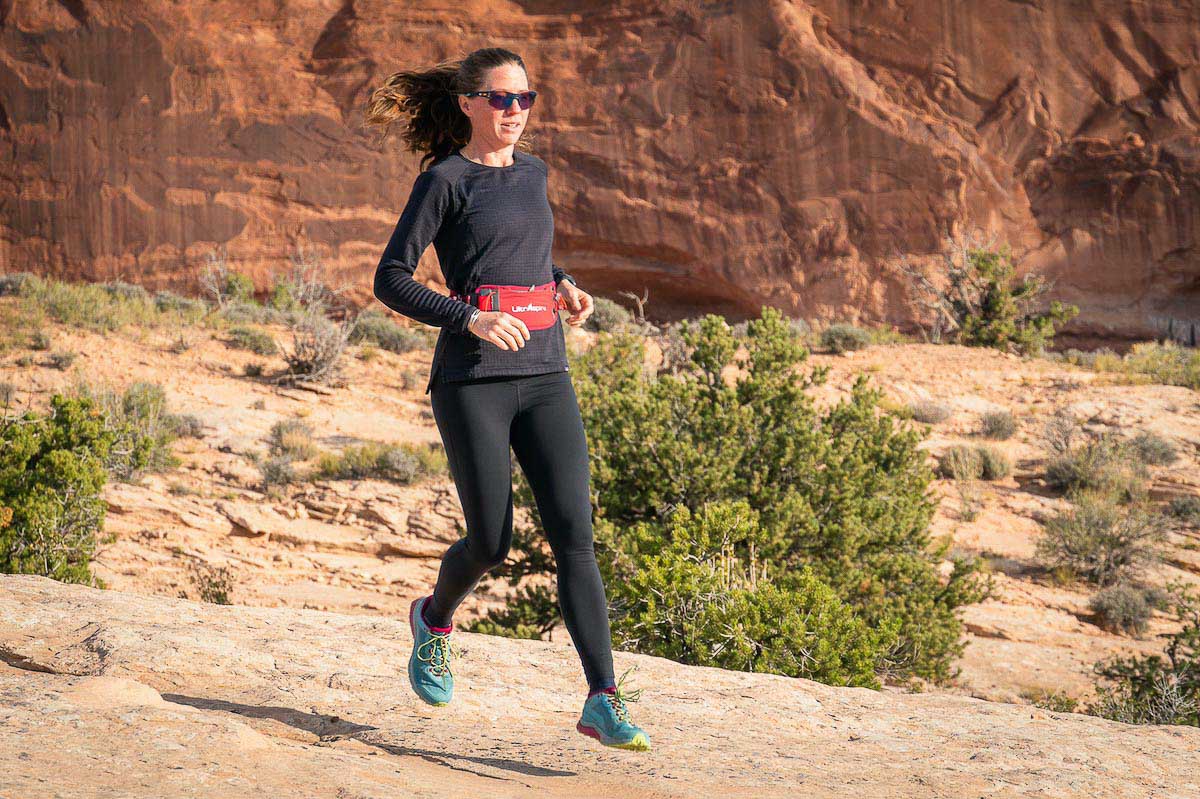
Testing the UltrAspire Synaptic 2.0 Waist Pack running belt in Moab, Utah. Photo: iRunFar/Eszter Horanyi
Best Overall Tube-Style Running Belt: Naked Running Band ($55)
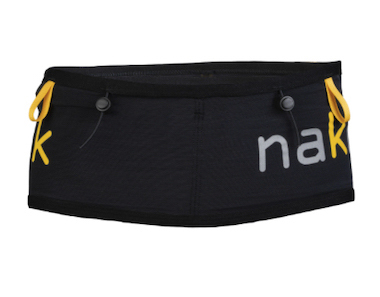 It’s been on the market for years, and many brands have tried their hand at a similar tube-style running belt, and yet the Naked Running Band remains the best waistbelt of this kind.
It’s been on the market for years, and many brands have tried their hand at a similar tube-style running belt, and yet the Naked Running Band remains the best waistbelt of this kind.
The stretchy, breathable tube-style running waistpack has three deep pockets circling the entire belt, with the largest one in the back suitable to fit even a full-size soft flask. The Naked Running Band has large elastic bands in which to slip your running poles, which is convenient, though you might be able to feel them in the small of your back. There are two bungee toggles for attaching a race bib and an internal key clip, too, both on the front of the belt.
We have found the Naked Running Band to have the most precise fit of all the tube-style running waistpacks out there, thanks to its 12 available sizes. The Naked website has a size chart, and multiple testers found the belts ran true to the advertised sizes.
Of note is that some but not all testers found that the tall height of the band scrunched up a bit around the abdomen, depending on body shape, especially if not much was being carried in it.
Actual weight: 2.3 ounces (67 grams)
Configuration: Three large top-loading pockets encircling the belt
Pros:
- Lots of storage
- Open pocket configuration allows you to store stuff exactly where you want to
- Stretchy and stable
Cons:
- Can feel poles on the lower back when stored with bands
- Can scrunch up depending on body type
Best Tube-Style Running Belt – Runner-Up: Salomon Sense Pro ($50)
The Salomon Sense Pro running belt is a great addition to this category from a brand with excellent hydration packs. We found that it stays put without scrunching up around the waist better than all the tube-style running belts — we think this is because it has a slightly smaller diameter at the top compared to the bottom.
There are two large and two small pockets between the front and sides, and adjustable bungee cords in the back make it easy to fit various-sized poles and ensure they don’t slip around. Two bits of foam padding in the waistbelt prevent the poles from pressing on your lower back, which is a nice touch. Take note that you can also use those external bungees to securely carry an extra layer like a rain or wind jacket.
The largest pocket on the back reserves space for a full-size soft flask, though it’s probably not the best to have a soft flask and poles on board at the same time. The front pocket has a fold-over opening, which makes carrying your phone feel secure.
Of note is that it takes a bit to get used to working this pocket on the run, but once you do, it’s simple to access your phone for a quick photo or text message. The other three pockets open from the top.
Actual weight: 2 ounces (57 grams)
Configuration: One large and two small top-loading pockets on the back and sides; one large pocket with a fold-over opening on the front
Pros:
- Stays put on the waist and has very little bounce
- Solid and comfortable system for carrying poles
Cons:
- No key clip
Best Tube-Style Running Belt – Runner-Up: UltrAspire Fitted Race Belt 2.0 ($33)
 The UltrAspire Fitted Race Belt 2.0 innovates in the tube-style running belt category with its shape that’s taller in the front and shorter in the back, thanks to curves on the bottom edge of the waistpack.
The UltrAspire Fitted Race Belt 2.0 innovates in the tube-style running belt category with its shape that’s taller in the front and shorter in the back, thanks to curves on the bottom edge of the waistpack.
This belt has three large pockets that will hold your phone, hydration, nutrition, and anything else you may want to carry. One of these pockets closes with a vertical zipper, which is handy if you want to ensure that your keys don’t fall out, while the other two open at the top.
Bungee cords on the back securely carry your poles or an extra layer of clothing. The largest pocket on the front will comfortably carry a full-size soft flask. There are two bungee toggles with which to attach your race bib.
Actual weight: 2.4 ounces (68 grams)
Configuration: Two large top-loading pockets and one pocket with a vertical zipper encircling the belt
Pros:
- Curved shape fits ergonomically on hips
- Zippered pocket allows secure storage for keys, cards, and trash
- Best price in the tube-style running belt category
Cons:
- Can scrunch up if not carrying much in the pockets
Best Running Belt for Hard-Sided Water Bottles: Nathan Peak Hydration Waist Pak ($40)
 Now we move into the running waistpacks with a bit more heft, where the Nathan Peak Hydration Waist Pak sits atop our list. This pack shines when it comes to carrying water in its included hard-sided Nathan Speed Draw Flask with the push/pull Race Cap, which carries 535 milliliters (18 ounces).
Now we move into the running waistpacks with a bit more heft, where the Nathan Peak Hydration Waist Pak sits atop our list. This pack shines when it comes to carrying water in its included hard-sided Nathan Speed Draw Flask with the push/pull Race Cap, which carries 535 milliliters (18 ounces).
The included flask is ergonomically shaped and flat on one side, allowing it to sit nicely against the small of your back. Also, its curved sides and bump on the outer face make this comfy for hands of many sizes to hold. Finally, it’s super smooth to both pull out and replace the flask in its designated holster while running.
For storage, this pack offers just one zippered pocket that wraps around the left back side for your phone, key, and a couple of snacks. To the right side of the water bottle holster is an adjustable bungee cord that allows you to stow a small jacket, hat, or gloves. Overall, the storage is pretty minimal.
This running belt has no bounce — none at all — courtesy of its wide webbing and overall shape meant to fill much of the surface area in the small of your back. One of our testers even found the wide webbing to be overkill for this small pack, though others appreciated it for the stability it offers.
The single-size Nathan Peak Hydration Waist Pak’s belt connects at the front with a buckle and adjusts to fit most body sizes.
In case you’re wondering, a few other hard-sided water bottles do fit into this waistpack, but not with the precision fit of the included Nathan Speed Draw Flask.
Actual weight: 6.3 ounces with the included hard-sided water bottle (178 grams)
Configuration: Water bottle holster and one zippered pocket on the back
Pros:
- Carries a hard-sided water bottle better than any waistpack we tested
- Included water bottle slips in and out easily
- No bounce
Cons:
- Limited storage beyond carrying water
- Doesn’t come in multiple sizes to accommodate the widest array of body types
- No key clip
Best Running Belt for Hard-Sided Water Bottles – Runner-Up: UltrAspire Synaptic 2.0 Waist Pack ($60)
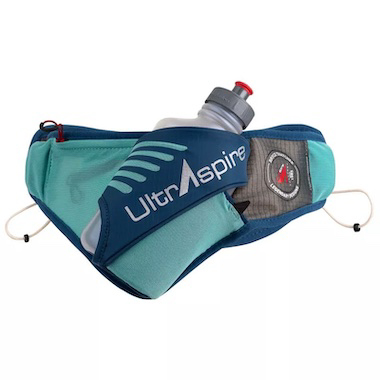 Another great waistpack to carry a hard-sided water bottle is the UltrAspire Synaptic 2.0 Waist Pack. It’s a hefty one, weighing in at nearly half a pound, making it the heaviest waistpack in this guide. That said, it also carries a bunch of stuff very comfortably.
Another great waistpack to carry a hard-sided water bottle is the UltrAspire Synaptic 2.0 Waist Pack. It’s a hefty one, weighing in at nearly half a pound, making it the heaviest waistpack in this guide. That said, it also carries a bunch of stuff very comfortably.
This was the favorite bottle-carrying pack of iRunFar’s Meghan Hicks: “There’s no bounce, and it’s quite comfortable … there’s no banging of the bottle on the lower back, nothing digs into my middle. You do have to pull the bottle quite hard to get the bottle out, but you get used to it.”
While this pack is heavier than some others, UltrAspire once again prioritized comfort and ergonomic fit. Other than the bottle holster, the waistpack sits pretty flush against your back and stomach, making bouncing nearly impossible.
The zippered back pocket doesn’t hold as much as we’d like, but the front pocket, which opens at the top, held enough nutrition for a four-hour-long run and could have held even more. If you want to carry a phone, you’ll need to keep it in the front pocket. Note that there is a key clip in the back pocket.
In a switch from some of the other running belts in this guide, this one has bungee cords in the front to carry your poles or extra clothing.
The waistpack’s one-size-fits-most system adjusts quite widely to provide a stable fit on many body types. Though it works great, all of our test team found the large metal buckle to be far overbuilt for this pack’s needs.
We really like the included UltrAspire UltraFlask 550 Hybrid Bottle — it’s not really soft, and not really hard, quite flexible, and lighter than others.
Actual weight: 7.9 ounces with the included water bottle (225 grams)
Configuration: Water bottle holster and one small zippered pocket on the back; one large top-loading pocket on the front
Pros:
- Shines in carrying the excellent, included hard-sided water bottle
- Sits very solidly on the body with no bounce
- Bigger-than-it-seems pocket in the front
Cons:
- Heavy weight
- High price
- Doesn’t come in multiple sizes to accommodate the widest array of body types
Best Overall Mini-Belt: Nathan Zipster Lite ($30)
The Nathan Zipster Lite is best for a run where you don’t need to carry water around your waist. This running belt is the one to use if you want to go minimal and just carry your phone, key, and perhaps one snack.
Coming in a wide variety of colors and sizes, this belt is lightweight, though it does weigh as much as tube-style running belts with larger carrying capacities.
The Zipster Lite has four pockets, two on the sides that fold over to close, and one each on the front and the back with zippers and water-resistant material inside. It’s a tight fit for a smartphone in the zipper pockets, but it works.
While the water-resistant pockets are a nice touch, one of our testers noted this made the belt feel too warm in warmer weather.
A female tester did find some movement with the waistbelt riding up when sized according to Nathan’s sizing chart, so she recommends women size down if they are on the cusp of two sizes.
Actual weight: 2.2 ounces (63 grams)
Configuration: Two large zippered pockets on the front and back; two fold-over pockets on the sides
Pros:
- Great price
- Variety of pockets
- Many colors and a wide size range
Cons:
- Can ride up for some women
- Belt can get a little warm because of multiple layers of material, including water-resistant material in some parts
- Phone pocket is tight, so it’s tricky to remove and replace it on the move
Best Mini-Belt – Runner-Up: Nathan 5K Waist Belt ($25)
The Nathan 5K Waist Belt is the running belt to use if you’re seeking no-bounce minimalism.
The back sits flush and securely against the body, offers some nice reflective detail for those early-morning or night runs, and the front closes easily with a click of the plastic buckle.
One of our testers stored a phone and an ultralight wind jacket in the pack, and it didn’t bounce while carrying more than we expected it would be able to hold.
The black version has strap keepers for the adjustable straps, while the other colors don’t, which is a bummer that we fixed by trimming excess belt material. A couple of testers said they got quite warm wearing it, possibly from its use of neoprene, the same material used in wetsuits.
This isn’t the most innovative waistpack, but if you want an affordable and easy-to-use belt, this is a great choice, especially if you run colder.
Actual weight: 3.5 ounces (100 grams)
Configuration: One large and one small zippered pocket on the back
Pros:
- Minimal bounce
- Easy to take on and off
- Excellent price
Cons:
- Thick material, will get sweaty in warmer weather
- No key clip
Best Running Belt for One Soft Flask: Ultimate Direction Race Belt ($55)
 For a traditional-style waistpack that’s easily able to carry a full-size soft flask, the Ultimate Direction Race Belt is perfect.
For a traditional-style waistpack that’s easily able to carry a full-size soft flask, the Ultimate Direction Race Belt is perfect.
This belt closes in the front with a Velcro layover rather than a buckle clasp, meaning there’s no extra strap material hanging over the side.
There are three pockets on this waistpack. First, on the front right side, there is a tiny pocket meant specifically to hold your key. On the back are two pockets. The main pocket is for carrying a soft flask that loads from the top and has a snap closure, and the internal zipper pocket is where you can securely carry your phone. That internal zipper pocket also has a key clip.
Adjustable bungee cords on the back allow you to attach poles or an extra layer, which can be used comfortably in conjunction with carrying a soft flask.
Should you desire more storage than what’s here, this waistbelt is made specifically to pair with the Ultimate Direction Adventure Pocket, which can attach to the front.
This running belt is made to carry soft flasks, so unlike other waistpacks, where the soft flask can stretch the mesh or bounce around a bit, the Ultimate Direction Race Belt design is such that the soft flask in the back sits nicely, slides out and in easily, and does not bounce. We all know handling soft flasks can be a wiggly experience, and this belt offers a streamlined solution.
Finally, this comes with one Ultimate Direction Body Bottle II 500-milliliter soft flask.
Actual weight: 3.6 ounces with the included soft flask (104 grams)
Configuration: One large top-loading pocket and one zippered pocket on the back; one tiny Velcro pocket on the front
Pros:
- Super easy to access and stow the included soft flask
- No hanging straps thanks to Velcro closure
- No bounce and a very comfortable ride
Cons:
- Must add on Ultimate Direction Adventure Pocket if you want extensive storage in addition to carrying water
- Velcro catches on some clothing materials and gloves
- High price
Best Running Belt for Two Soft Flasks: Ultimate Direction Ultra Belt ($75)
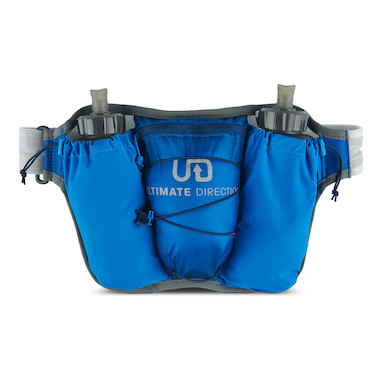 Ultimate Direction is always clutch with innovative gear-carrying tools, and the Ultimate Direction Ultra Belt is no different. This is the most expensive running belt of the bunch, but it functions much more like an actual running vest than its competitors.
Ultimate Direction is always clutch with innovative gear-carrying tools, and the Ultimate Direction Ultra Belt is no different. This is the most expensive running belt of the bunch, but it functions much more like an actual running vest than its competitors.
This waistpack has the largest carrying capacity of any others on this list, able to fit two full soft flasks at angles on the lower back in dedicated pockets with bungee closure tops. Take note that these pockets store other gear really well should you not need to carry two soft flasks.
A zippered pocket between the bottles can fit your phone, a wind jacket, snacks, and anything else you might want, though some testers stated they struggled to get the largest of phones inside when carrying two full soft flasks. Of note is a hidden pocket within this zippered pocket with a Velcro top where you could securely stow a key and cards. An adjustable bungee cord overlays the zipper pocket for holding an extra layer, hat, or gloves.
Like the Ultimate Direction Race Belt above, the Ultra Belt has a tiny pocket just for your key with a Velcro closure in the front. You can also pair this waistbelt with the Adventure Pocket for even more storage.
Finally, the waistpack comes with two of the Ultimate Direction Body Bottle II 500-milliliter soft flasks.
We took this waistpack on an all-day adventure where we were able to carry one soft flask, running fuel for seven hours out, a rain jacket, gloves, a water filter, a phone, and a small headlamp. In effect, it comfortably and easily held all we would have carried in a hydration pack.
Actual weight: 5.3 ounces with the two included soft flasks (150 grams)
Configuration: Two soft flask holsters, one large zippered pocket, and one small Velcro pocket on the back; one tiny Velcro pocket on the front
Pros:
- Massive carrying capacity
- No bounce as it sits low and secure on back
Cons:
- Highest price of any waistpack in this guide
- Velcro catches on some clothing materials and gloves
Best Budget Running Belt: Decathlon Kalenji Adjustable Running Belt ($14)
 The Decathlon Kalenji Adjustable Running Belt is the most minimalist of running belt here, and it’s also the easiest on your wallet. If you want a belt that holds your keys and phone for well under $20, then this one is for you.
The Decathlon Kalenji Adjustable Running Belt is the most minimalist of running belt here, and it’s also the easiest on your wallet. If you want a belt that holds your keys and phone for well under $20, then this one is for you.
Decathlon is an interesting company. They’re a sort of wholesale producer who claims to cut out the middleman, saving the customer costs without decreasing product quality. While this may not hold true for all their products, we loved this tiny and compact waistbelt. It is simple and straightforward, the zippered pocket is large enough to hold even the biggest phones, and the buckle closure makes taking it on and off a breeze.
The back pocket is divided into two sections, allowing you to keep your key pretty darn secure even while reaching for other items.
In the future, we’d love to see the zipper moved higher on the pocket so a phone feels more secure when placing it in or removing it from the pocket. If you don’t need to carry much, go with this waistpack.
Actual weight: 1.9 ounces (55 grams)
Configuration: One large zippered pocket on the back
Pros:
- Really inexpensive
- Lightest running belt in this guide
Cons:
- Not much storage
- No key clip
Shop the Decathlon Kalenji Adjustable Running Belt
Buyer’s Guide: How to Choose a Running Belt
Choosing From the Various Styles
The best running belts and waistpacks seem to be divided into three general categories:
- Tube-style belts: Ultralight, minimalistic, and adaptable to what you’d like to carry in them
- Mini-belts: Small waistpacks meant only to hold your keys, card, and phone
- Larger waistpacks built around carrying specific water bottles: Besides hydration, these can additionally hold snacks, extra layers, and more
The style you choose depends on your run. For a quick three miles around the block with shorts that don’t have pockets to carry your keys, the Nathan Zipster Lite would do the trick. A trail marathon with lots of aid stations for refilling water bottles or a remote high-altitude adventure where you’re largely self-reliant will each warrant a different style of running belt.
The style you use is also a matter of personal preference and comfort. For example, the best running belt for a minimalist is different than for someone whos loves to drink out of hard-sided water bottles. Whatever you desire, there’s a waistpack in this guide made for you.
Fit
Many people choose running belts and waistpacks over hydration packs due to the fact they place more weight on the hips and waist rather than the shoulders, and they also reduce coverage of your chest and back for better ventilation and lower risk of chafing.
Each runner’s body type will partly dictate the best running belt for it, both from a body shape and composition standpoint. The right kind of belt or waistpack will sit snugly around the body without being too tight and without riding up or falling down while moving. Some brands do this better than others, and a style that works for one person may not work for another or from one gender to another.
We’ve found that men and women wear waistbelts differently — men have a much straighter line from waist to hips, and women tend to taper at the waist and widen at the hips. As a result, men tend to wear them at the natural hips and women at the narrowest point on their bodies.
It’s always best when you can try a waistbelt on before you purchase to make sure you get the correct size. When buying online, follow each brand’s sizing charts and instructions. Some, like the Salomon Sense Pro, will indicate that they run a little small, and you should go for the larger if you fall between sizes.
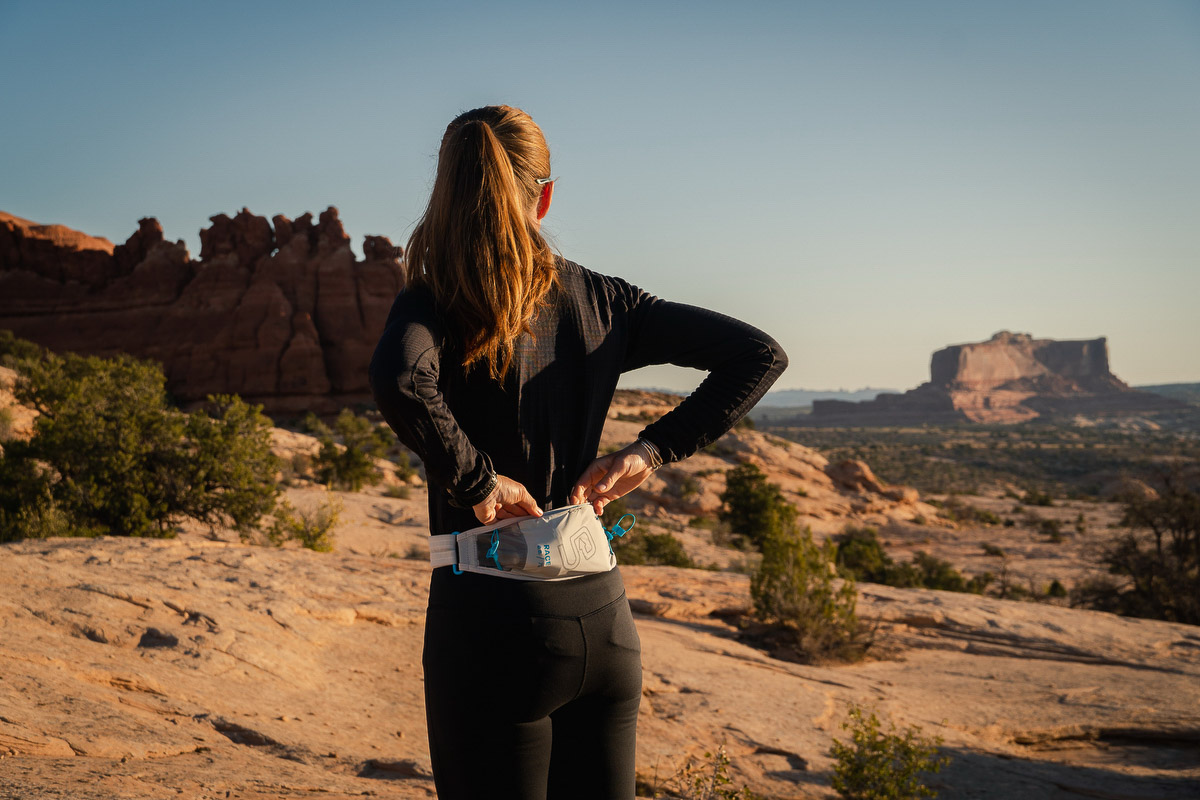
iRunFar Managing Editor Meghan Hicks tests the Ultimate Direction Race Belt on a run outside Moab, Utah. Photo: iRunFar/Eszter Horanyi
Storage and Size
Even within the three categories of running belts, there are a variety of storage capacities among different designs and styles. The best running belt for you may be a simple, solid belt that can hold water, such as the Naked Running Band, or a maximal waistpack with lots of capacity, like the Ultimate Direction Ultra Belt. Or you may prefer a wider-width belt that feels better on your abdomen than a thin one, even though you’re not carrying as much.
You may also take into account how easy it is to access the items you are storing: Are there zipper pockets, magnetic closures, or fabric overlays? Do the items you’re carrying feel solid and secure while running? The list we’ve compiled above includes an option to suit the needs and preferences of just about anyone.
Sweat Factor
Like other running gear, we look for running belts and waistpacks that have good airflow and are able to wick sweat when possible, keeping chafing and wet waists to a minimum. Maybe you run a bit cold and may actually prefer a waistbelt with thicker material, but your best bet for comfort is still to buy one that dries quickly.
Another reason why people wear waistpacks instead of running vests is due to the decreased surface area it covers on our backs and chests, thereby allowing us to thermoregulate more easily. A pack like the Ultimate Direction Ultra Belt will hold almost as much as a running vest and may work better for warm-weather training and racing.
Stomach Comfort
For some people who might be sensitive to pressure or material around their stomachs while running, a waistbelt might not be the right solution at all. The best running belt for a person who doesn’t like a tight feeling around their abdomen and still wants to try a waistbelt could be one that stretches easily, like the Naked Running Band, or has an adjustable strap, such as the Nathan Peak Hydration Waist Pak, which can be changed to different comfort levels.
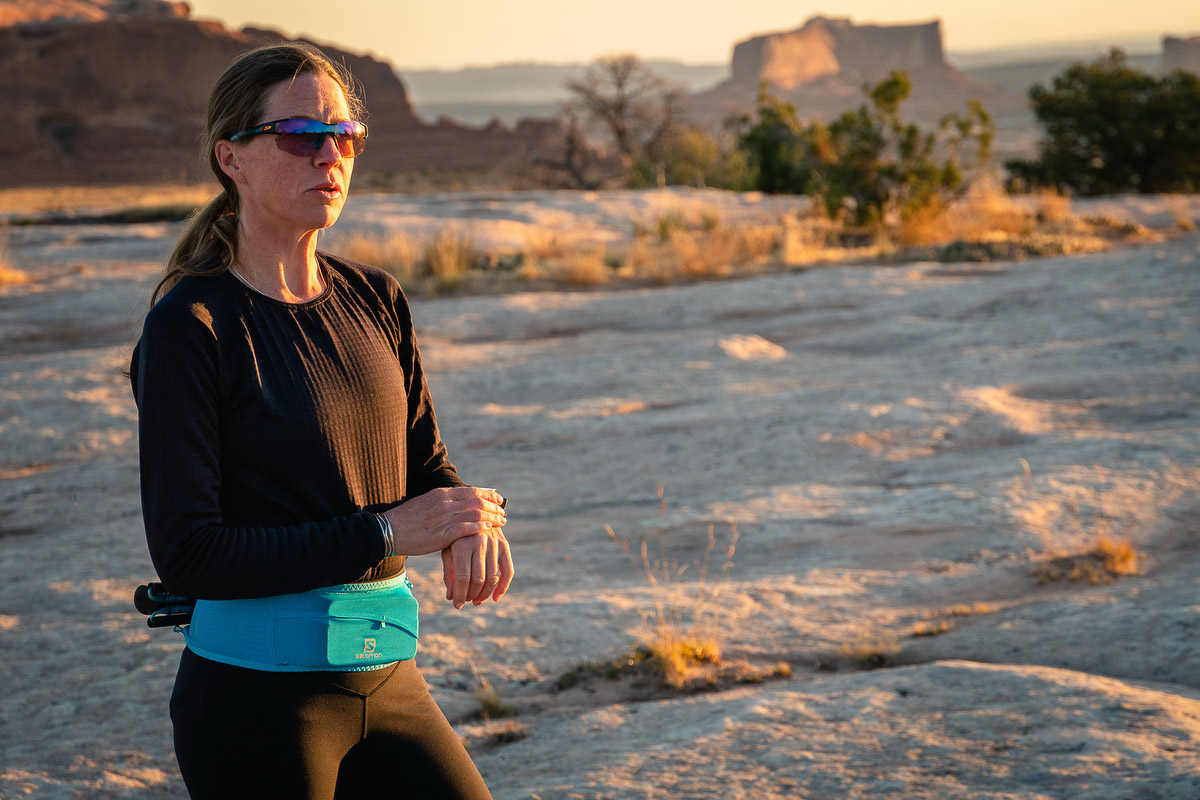
The Salomon Sense Pro offers plenty of room to carry your phone, hiking poles, water, and snacks. Photo: iRunFar/Eszter Horanyi
Why You Should Trust Us
iRunFar’s robust testing process ensures you get the best gear for your needs. We consider quality, durability, cost, and a host of other elements when choosing which models of gear to test.
Based on decades of experience as runners and gear reviewers in this space, we extensively researched the running belts and waistpacks marketplace before choosing roughly 20 top candidates for extensive testing.
We then put the products through the paces on mountains and singletrack and through rocks, mud, rain, and a couple of truly epic storms. Additionally, we tested these running waistbelts through all four seasons. Eventually, we identified the best running hydration belts to put in this guide.
Please note that in the running world, product models are routinely discontinued, while new ones frequently come to market. At the same time, we here at iRunFar often keep using our top picks in our daily running … they’re our top picks, after all! Sometimes that continued use results in uncovering product failures. With all this — product discontinuations, new product introductions, and product failures — in mind, we routinely update our buyer’s guides based on past and ongoing testing as well as research by our authors and editorial team. While these updates can appear to be us pushing the newest product, it’s anything but that. When we update any buyer’s guide, most of the products are likely to remain the same. That matches our goal: to get you in the best gear that you’ll be using for a long time.
Frequently Asked Questions About Running Belts and Waistpacks
What’s the difference between a running belt, waistpack, and waistbelt?
Not a whole lot! These terms are generally used interchangeably by brands marketing their products, though waistpacks, like the UltrAspire Synaptic 2.0 Waist Pack, often have more carrying capacity than a belt, like the Decathlon Kalenji Adjustable Running Belt. All of the names refer to a piece of gear that is worn around the waist and which has pockets and holsters for storing water and gear. For ease, we also use these phrases interchangeably in this guide.
Why would I use a running belt or waistpack instead of a hydration vest?
In general, it comes down to the length of your run and what you need to carry, as well as personal preference. If your run is less than an hour, and the weather isn’t scorching, it’s unlikely you’ll need much water. In this scenario, it’s often unnecessary to carry a full running vest when all you need to carry are your keys and a phone, all of which you can fit in a small belt like the Decathlon Kalenji Adjustable Running Belt.
For some people, using a belt also takes up less space on the chest and back, increasing ventilation and helping them stay cool.
Why should I use a running belt instead of pockets on my running shorts or tights?
In reality, both a running belt or your running shorts or tights can be great options for storing a relatively small volume of gear, so it’s a matter of personal preference and what feels the most comfortable for you.
We will say, after having tested many shorts and tights over the years, there are few garments that hold more than your keys and perhaps one snack without issue, so often, a running belt opens up the opportunity to carry a little more, such as a phone or water bottle. Even a minimalist belt like Nathan Zipster Lite will hold the essentials for a short run.
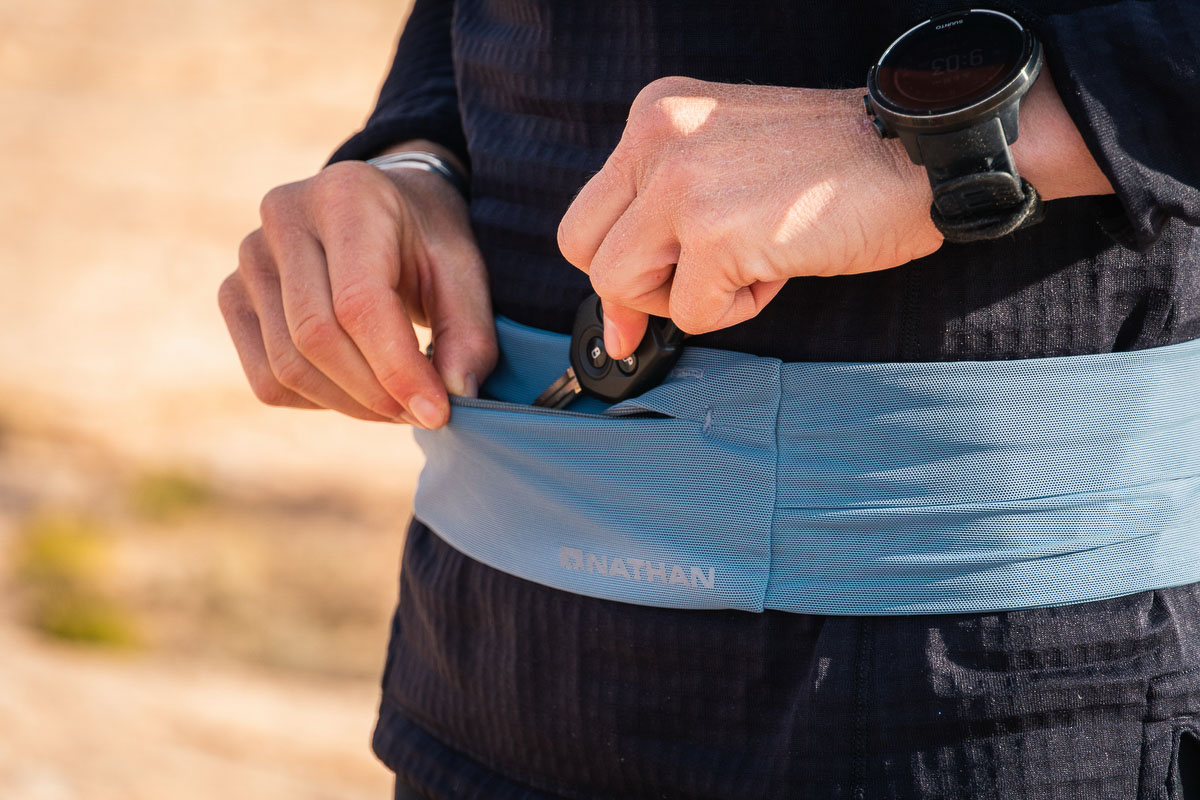
The Nathan Zipster Lite sits flush against the abdomen with flat pockets for items. Photo: iRunFar/Eszter Horanyi
What are the benefits of choosing a running belt that carries water?
This comes down to distance or your personal hydration needs — maybe your run is in the two-hour range in moderate weather, long enough that you’d like to hydrate, but short enough that you don’t need the liter or more of water storage capacity a hydration vest offers. Running hydration waistpacks like the Ultimate Direction Race Belt that carry a single soft flask, or the UltrAspire Synaptic 2.0 Waist Pack, which can hold a hard-sided water bottle, can be the perfect complement to runs like this.
What can I carry in a running belt or waistpack?
Anything you want. The standard is keys, running fuel, phone, and maybe hydration. For belts with a larger carrying capacity, like the Ultimate Direction Ultra Belt, you can add in an extra layer, enough calories for a couple of hours on the trail, and even hiking poles.
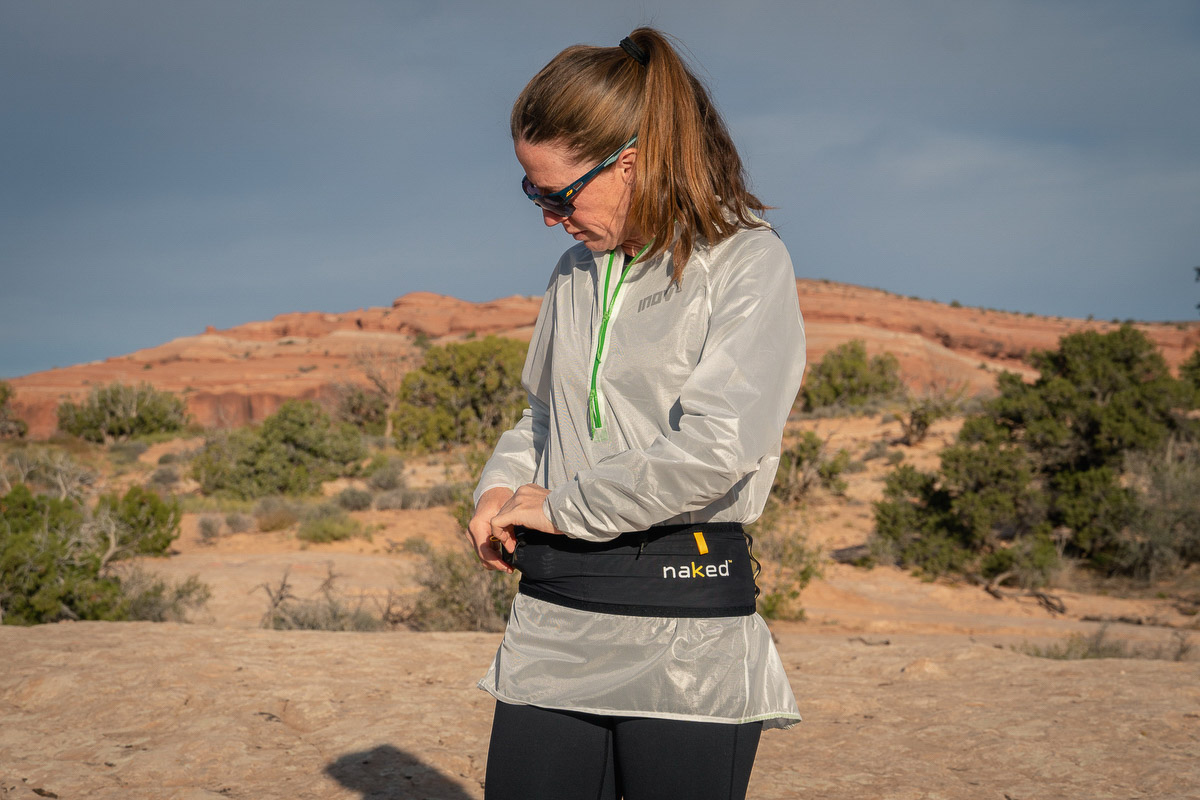
iRunFar’s Meghan Hicks placing items in the Naked Running Band during a run in the high desert. Photo: iRunFar/Eszter Horanyi
How do I keep my stomach comfortable when I’m wearing a running belt?
Some people like a slight compressive feeling around the middle, while others absolutely hate any pressure over the abdomen. If you’re in the second camp and still want to find the best running belt for short runs, choose one that stretches very easily, like the Naked Running Band. If possible, we recommend trying out a few different sizes to see what feels best for you.
An alternative is where you wear the pack on your body; for men, this is a bit easier, as their body shape allows them to fit a waistbelt on the true hips rather than over the stomach.
Call for Comments
- Do you prefer a running belt or a handheld water bottle when you’re on a shorter mission that doesn’t require a hydration pack?
- What are your favorite running belts, maybe some that we didn’t review in this guide? Let us know, and we’ll consider them for future updates to this article!
